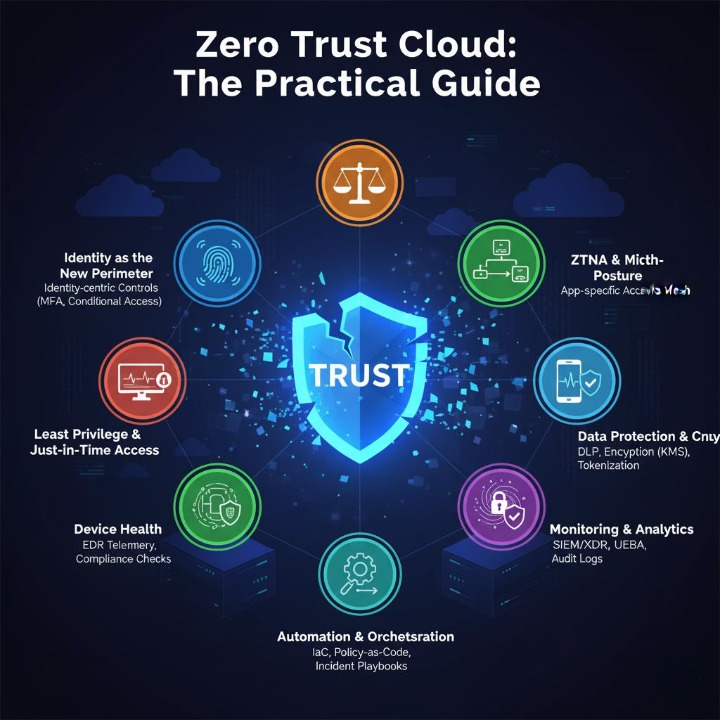Introduction
Cloud adoption has reshaped enterprise security. Traditional perimeters have dissolved, workloads are distributed, and users connect from anywhere.
This has expanded the attack surface, making old “castle-and-moat” security models obsolete.
The solution is Zero Trust Architecture (ZTA) - an approach that enforces continuous verification of identities, devices, and workloads.
This guide explores how to implement Zero Trust in the cloud, based on NIST SP 800-207, NCCoE practice guides, and real-world best practices.
Why Zero Trust Matters for Cloud
- Eliminates reliance on network perimeters.
- Reduces risk of lateral movement by attackers.
- Aligns with hybrid, multi-cloud, and SaaS environments.
- Supports regulatory compliance and data sovereignty.
- Improves resilience against identity-based attacks.
Core Principles of Zero Trust (NIST)
1. Authenticate and authorize every request.
2. Grant least privilege access.
3. Continuously monitor device and user posture.
4. Enforce policies dynamically using context.
5. Protect all resources regardless of location.
Pillars of Cloud Zero Trust
1. Identity and Access Management (IAM): Centralize identity with MFA, SSO, and conditional access.
2. Zero Trust Network Access (ZTNA): Replace VPNs with identity-based secure access.
3. Least Privilege Access: Implement ABAC/RBAC with just-in-time access.
4. Device Posture Verification: Integrate EDR/MDM data for access decisions.
5. Micro-Segmentation: Control east-west traffic with VPC policies or service meshes.
6. Data Security: Encrypt data at rest and in transit, apply DLP.
7. Telemetry and Analytics: Centralize logs, monitor with SIEM/XDR, enable UEBA.
Implementation Roadmap
Phase 1: Identity Hardening - Enforce MFA, consolidate identity into one IdP.
Phase 2: ZTNA Adoption- Replace VPNs with ZTNA pilots for select apps.
Phase 3: Segmentation - Apply micro-segmentation and workload identities.
Phase 4: Device Posture- Require healthy devices for access.
Phase 5: Data Protection - Implement classification, DLP, and encryption.
Phase 6: Continuous Monitoring - Centralize logs, integrate SIEM/UEBA, and automate incident response.
Challenges and How to Overcome Them
- Legacy Apps: Use gateways and identity proxies.
- User Friction: Offer passwordless or SSO options.
- Policy Complexity: Adopt policy-as-code.
- Performance Issues: Deploy ZTNA regionally to reduce latency.
- Cost Concerns: Use native cloud security services to lower expenses.
Key Tools and Vendors
- Identity: Microsoft Entra, Google Cloud Identity, Okta.
- ZTNA: Zscaler, Palo Alto Prisma Access, Cloudflare Access.
- Micro-segmentation: Istio, Calico, VMware NSX.
- Device Security: CrowdStrike, Microsoft Defender, Intune.
- Telemetry: Splunk, Microsoft Sentinel, Elastic SIEM.
- Policy-as-Code: Open Policy Agent (OPA), Terraform.
Conclusion
Zero Trust in the cloud is not a single product - it’s a journey of continuous verification, least privilege, and adaptive security.
By starting with identity, piloting ZTNA, and expanding to data and device posture, organizations can significantly reduce cloud security risks.
With the right governance and automation, Zero Trust becomes a catalyst for resilience, compliance, and digital transformation.




